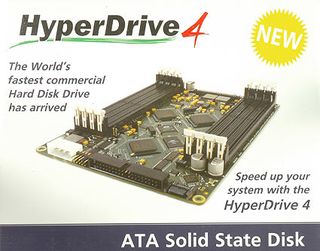HyperDrive 4 Redefines Solid State Storage
The HyperDrive 4 By HyperOS / Accelerated Logic

Now let's get into the new HyperDrive 4. The first thing we noticed when we browsed the vendor's website is the tremendous amount of information, which is not typical for storage devices - most companies provide a specification sheet and a lot of marketing-heavy data. That's also the case on http://www.hyperossystems.co.uk/, but everything is backed with benchmark data and information that I can only call hands-on experience, which is indeed useful to get a feeling for the HyperDrive. Although our benchmark results make very clear that this indeed is one of the fastest hard drive replacements we've seen, the numbers do not tell the whole story. The HyperDrive is an invention of Pascal Bancsi, who partnered with the Britsh company called HyperOS, from which we received the test samples. The root website for this product hence is http://www.acceleratedlogic.com/.
The layout of the HyperDrive 4 is similar to that of the HyperDrive III: it is still a 5.25" unit that accepts up to eight DDR1 ECC DIMMs, and it still installs easily into any available drive bay. HyperOS added two 40 mm fans at the front of the drive, which are used to properly cool the device. We did not notice it getting really hot, but there is certainly nothing wrong with being careful. Unfortunately, the fans are more than noticeable, and will override your efforts to create a quiet system. While the HyperDrive 4 clearly targets the professional market and extreme enthusiasts, a solid state drive would obviously seem to be ideal for service in a no-noise environment. At least HyperOS mentions on the website that the next generation might be entirely quiet...
On the back side you will find a Molex connector, which the drive uses to get its power, and an UltraATA connector and a SATA port. Unlike the HyperDrive III, which was UltraATA/100, the fourth generation utilizes UltraATA/133. The SATA port is also limited to the theoretical maximum of 133 MB/s. It's a pity that it still doesn't support native SATA, but we understand that the step from UltraATA/100 to 133 was easier and just as effective as going to SATA/150. A new HyperDrive with support for SATA/300 is in the works, and scheduled to launch in the first half of 2008.
It was very interesting to watch the SYSmark 2007 Preview results, because this application benchmark, which simulates popular applications, benefits considerably if the operating system and the benchmark are installed onto the HyperDrive 4. Clearly, the benchmark reflects that all the latencies we have to accept with conventional hard drives and even with Flash SSDs (write latency) are gone with the HyperDrive 4.
The only real drawback of the HyperDrive 4 seems to be its price: The bare product is currently priced at £1,195, which currently equals roughly $2,500 or €1,700. Typical users can almost buy a standard desktop PC and a notebook for that amount of money. If you want the version with up to 32 GB of memory, you'll have to fork out 50% more - and you still have to buy the memory! You can either buy DDR ECC memory at the retailer of your choice, or look at the HyperOS offerings: Eight 1 GB DIMMs cost £375 ($770 or €535), or you can go for eight 2 GB DIMMs for £995 ($2,040 or €1,420). The 32 GB memory package is a whopping five times more expensive! You might also want to add some money for the backup hard drive or Flash SDD, which is fairly cheap in contrast to the HyperDrive 4 and the memory.
HyperOS also offers a plethora of accessories, such as external eSATA models, drive cabinets and even bundles of multiple HyperDrives with memory and RAID controllers. The sky is the limit. We also want to make clear that HyperOS might not have much of an influence on memory cost. From this standpoint, we recommend switching to DDR2 memory, as this technology currently is cheaper than DDR1, even if ECC is required.
In the end, the HyperDrive 4 still left an excellent impression, as it works like any other hard drive and doesn't require drivers or any complicated installation, and its performance is stellar - both in terms of benchmark numbers and the subjective impression we got from using it.
Stay on the Cutting Edge
Join the experts who read Tom's Hardware for the inside track on enthusiast PC tech news — and have for over 25 years. We'll send breaking news and in-depth reviews of CPUs, GPUs, AI, maker hardware and more straight to your inbox.


There are two 40 mm fans in the front.


The HyperDrive 4 comes with a massive battery unit (on the left with blue color), a charger and all necessary cables.
Current page: The HyperDrive 4 By HyperOS / Accelerated Logic
Prev Page Hard Drives, Flash Drives, RAM Drives Next Page Inside The HyperDrive 4Most Popular

